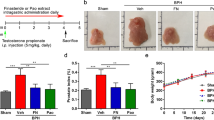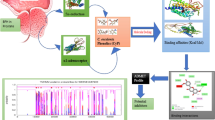Abstract
Introduction
The nicotinamide adenine dinucleotide phosphate (NADPH)-dependent membrane protein 5α-reductase irreversibly catalyses the conversion of testosterone to the most potent androgen, 5α-dihydrotestosterone (DHT). In humans, two 5α-reductase isoenyzmes are expressed: type I and type II. Type II is found primarily in prostate tissue. Saw palmetto extract (SPE) has been widely used for the treatment of lower urinary tract symptoms secondary to benign prostatic hyperplasia (BPH). The mechanisms of the pharmacological effects of SPE include the inhibition of 5α-reductase, among other actions. Clinical studies of SPE have been equivocal, with some showing significant results and others not. These inconsistent results may be due, in part, to varying bioactivities of the SPE used in the studies.
Methods
The aim of the present study was to determine the in vitro potency of a novel saw palmetto ethanol extract (SPET-085), an inhibitor of the 5α-reductase isoenzyme type II, in a cell-free test system. On the basis of the enzymatic conversion of the substrate androstenedione to the 5α-reduced product 5α-androstanedione, the inhibitory potency was measured and compared to those of finasteride, an approved 5α-reductase inhibitor.
Results
SPET-085 concentration-dependently inhibited 5α-reductase type II in vitro (IC50=2.88±0.45 μg/mL). The approved 5α-reductase inhibitor, finasteride, tested as positive control, led to 61% inhibition of 5α-reductase type II.
Conclusion
SPET-085 effectively inhibits the enzyme that has been linked to BPH, and the amount of extract required for activity is very low compared to data reported for other extracts. It can be concluded from data in the literature that SPET-085 is as effective as a hexane extract of saw palmetto that exhibited the highest levels of bioactivity, and is more effective than other SPEs tested. This study confirmed that SPET-085 has prostate health-promoting bioactivity that also corresponds favorably to that reported for the established prescription drug standard of therapy, finasteride.
Similar content being viewed by others
References
Shirakawa T, Okada H, Acharya B, et al. Messenger RNA levels and enzyme activities of 5 alphareductase types 1 and 2 in human benign prostatic hyperplasia (BPH) tissue. Prostate. 2004:58;33–40.
Boudon C, Lobaccaro JM. 5 alpha-reductase activity in cultured epithelial and stromal cells from normal and hyperplastic human prostates - effect of finasteride (Proscar), a 5 alpha-reductase inhibitor. Cell Mol Biol. 1995;41:1007–1015.
Comhaire F Mahmoud A. Preventing diseases of the prostate in the elderly using hormones and nutriceuticals. Aging Male. 2004;7:155–169.
Lee J, Andriole G, Avins A, et al. Redesigning a large-scale clinical trial in response to negative external trial results: the CAMUS study of phytotherapy for benign prostatic hyperplasia. Clin Trials. 2009;6:628–636.
Edwards JL. Diagnosis and management of benign prostatic hyperplasia. Am Fam Physician. 2008;77:1403–1410.
Abe M, Ito Y, Suzuki A, et al. Isolation and pharmacologic characterization of fatty acids from saw palmetto extract. Anal Sci. 2009;25:553–557.
Scaglione F, Lucini V, Pannacci M, et al. Comparison of the potency of different brands of Serenoa repens extract on 5alpha-reductase types I and II in prostatic co-cultured epithelial and fibroblast cells. Pharmacology. 2008;82:270–275.
Bent S, Kane C, Shinohara K, et al. Saw palmetto for benign prostatic hyperplasia. N Engl J Med. 2006;354:557–566.
Log T. Serenoa repens in benign prostatic hyperplasia. Tidsskr Nor Laegeforen. 2008;128:1293–1294. Article in Norwegian.
Reichert W, Harmann RW, Jose J. Stable expression of the human 5alpha-reductase isoenzymes type I and type II in HEK293 cells to identify dual and selective inhibitors. Proc Natl Acad Sci U S A. 2001;16:47–53.
Anderson S, Russell DW. Structural and biochemical properties of cloned and expressed human and rat steroid 5α-reductases. Proc Natl Acad Sci U S A. 1990;87:3640–3644.
Delos S, Lehle C, Martin PM, et al. Inhibition of the activity of ‘basic’ 5 alpha-reductase (type 1) detected in DU 145 cells and expressed in insect cells. Steroid Biochem Mol Biol. 1994;48:347–352.
Habib FK, Ross M, Ho CK, et al. Serenoa repens (Permixon) inhibits the 5 alpha-reductase activity of human prostate cancer cell lines without interfering with PSA expression. Int J Cancer. 2005;114:190–194.
Wilt TJ, Ishani A, Rutks I, MacDonald R. Phytotherapy for benign prostatic hyperplasia. Public Health Nutr. 2000;3:459–472.
Gerber GS, Kuznetsov D. Randomized, double-blind, placebo-controlled trial of saw palmetto in men with lower urinary tract infections. Urology. 2001;58:960–964.
Hizli F, Uygur MC. A prospective study of the efficacy of Serenoa repens, tamsulosin, and Serenoa repens plus tamsulosin treatment for patients with benign prostate hyperplasia. Int Urol Nephrol. 2007;39:879–886.
Lowe FC, Ku JC. Phytotherapy in treatment of benign prostatic hyperplasia: a critical review. Urology. 1996;48:12–20.
Wilt T, Ishani A, MacDonald R. Serenoa repens for benign prostatic hyperplasia. Cochrane database Syst Rev. 2002;(3):CD001423.
Author information
Authors and Affiliations
Corresponding author
Rights and permissions
About this article
Cite this article
Pais, P. Potency of a novel saw palmetto ethanol extract, SPET-085, for inhibition of 5α-reductase II. Adv Therapy 27, 555–563 (2010). https://doi.org/10.1007/s12325-010-0041-6
Received:
Published:
Issue Date:
DOI: https://doi.org/10.1007/s12325-010-0041-6




